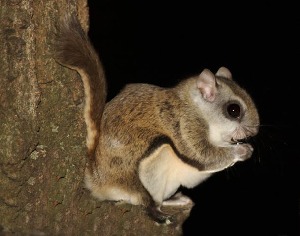Late-Night Flying Circus
Strange critters in our window feeder.

It was 2 a.m. We were new to the house, city folks getting used to country living, wary of thumps in the night and what varmints might be lurking outdoors–maybe trying to get indoors. We’d already seen a wild turkey cross our driveway, a red fox traversing our lake, and a sharp-shinned hawk eyeing the day-birds from its perch on the maple tree outside our kitchen window.
Something was out there, rustling around in the new bird feeder we’d just attached to the balcony overlooking our lake. All we could see, without turning on a light, was something small and unusual. Birds don’t feed there at night, nor do ground squirrels’we knew that much from living in the city.
We had plenty of wildlife around our old house’possums, raccoons, fox and gray squirrels, the occasional chipmunk, mice, crows, pheasants, birds galore. But nothing like this.
I flipped on the light silhouetting the balcony and the lake beyond. The tiny figure stayed where it was, stuffing its face with millet, corn and sunflower seeds. I grabbed my trusty nature book, trying to identify this sweet creature of the night with its enormous eyes, hamster body and flat, fuzzy tail.
Not a mouse. Not a vole. Not a chipmunk. Not a rat; the tail was all wrong. Not a red squirrel, gray squirrel, fox squirrel’they’re not nocturnal feeders.
Soon the lithe creature was joined by a partner, which noshed on the opposite side of the see-through feeder. Another one swooped down from the tree next to the balcony–then another and another.
Then I came upon their identity in the book: flying squirrels! Fuzzy little white-bellied babies, whose length, tail and all, is a diminutive 9-12 inches. The flat tail helps them glide up to 160 feet from tree to tree; the big black eyes allow them to see at night ‘ they’re the only nighttime food foragers in the wild world of North American squirrels.
They were doing a clownish ballet, their evening reverie, a flight of fancy into our feeder. Swinging from twig trapezes, flaps of silky underarm skin steadied their fall. Like two rapt cats, my husband and I watched, entranced by this late-night show.
Each time one crawled into the feeder, it knocked another out. It soared to the ground, 15 feet below, scrambled back up the tree, springboarded off the very tip of the branch, held its arms and legs out like a plane, and landed on top of the feeder again. They performed for hours. Feasting, jumping, eating, diving, balancing precariously on the peak of the feeder. Our very own Flying Wallendas!
The next time we caught their act, we didn’t need a light, though they didn’t seem to care that they were being watched the first time. A full moon lit up the snow and turned the rolling hillside a pale, shimmering blue. The big-eyed banditos were already chowing down and gliding around the feeder. Forget the shows on cable; the flying squirrels became our must-see TV.
Now that we’re getting acclimated to the bumps and groans of our house, we’re not staying up so late, wondering if we should worry about anything. So we’ve missed the acrobatic act more than we’ve seen it lately.
Then again, we’ve started thinking about that sharp-shinned hawk we see from time to time. A couple days ago, it was perched atop our feeder.
We’re hoping, next time we’re staring out at the feeder with the glazed eyes of insomniacs, that we’ll catch the evening acrobats one more time–and that the hawk hasn’t turned our after-dinner show into its late-night snack.
(This story originally appeared in Traverse magazine.)
